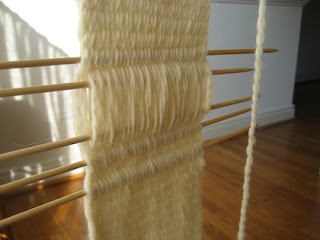August 04, 2012
Z Twist Språng Interlinking with Loosely-spun Handspun
It is true, språng fabric wants to twist when you work all Z twist interlinking. The top photo is taken squarely facing the frame on which the threads are stretched, and you can see how the cloth twists. Once taken off the frame, it really twisted.
You can see from the ends of yarn hanging loose that the yarn was spun Z and plied S, which means that the språng Z twist interlinking on the top section slants in the opposite direction of the yarn. In contrast, the bottom section shows in reverse whatever I do at the top and there the interlinking slants in an S direction. The twist of the interlinking fabric affects the strands of yarn, either undoing the yarn's twist or making it tighter. The fabric reflects this: I can see the twist in the yarn in the fabric's bottom section but it is hardly visible in the surface at the top. I like the look of the bottom section, that is, the section interlinked in the same direction as the yarn was plied.
The fabric is nice to the touch. As with my first two samples, it's fun to pull the cloth sideways to see the interlinking. Though the fabric corkscrews when held in the air, it lies flat when I fold it at the meeting line in the middle and set it on a table. Again this is a confirmation of what Collingwood has written. Nice to have a tangible example at hand. The sample is good for showing språng to people who haven't read the book and may never do so. The structure of this piece is easier to grasp than the last two. There are more variations to try out and prove.
The next experiment will be with the two yarns I spun, one spun Z and plied S and the other spun S (widdershins) and plied Z. I know I will arrange them on the frame AABB, but I am trying to decide whether to work all Z twist interlinking again or whether to work the cloth's right side with Z interlinking and the left side S. I think that would make the top and bottom sections exactly the same. Working all Z twist or all S twist would not. When you think about one portion of språng cloth turning out a little differently than the other, this has design implications for a piece of cloth to be worn. Since I intend to make myself something wearable with språng, I must mull this over. I can take very strong likes and dislikes to things, and I like to get what I like. Don't we all! It would be good to find a technical solution, a means to get the effect I like without completely discarding half the cloth.
I had another look at Blue Swan's pullover. She says on the page that the pullover is warm to wear. She worked so many holes in the interlinking, it's nice that it's warm even so. Plain interlinking has holes enough in my opinion. This is probably why I worked my interlinking so tightly, to minimize the holes. Tight interlinking is supposed to worsen the corkscrew effect.
What else did I learn? The amount of tension on the frame doesn't seem to matter much. Not like weaving where fabric goes flooey when the tension is loose.
I had crochet cotton on the frame last week and couldn't get anywhere with it.
Subscribe to:
Post Comments (Atom)


No comments:
Post a Comment
please use your good sense when commenting to protect your privacy and respect other people, thanks. No spam, please.